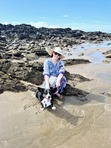Book Review: Where the Birds Call Her Name by Claire van Ryn
Broome 2023: when Saskia’s free-spirited mother leaves her a caravan in her will, it doesn’t make sense. Saskia is a schoolteacher, tied to plans and schedules, even if they are beginning to feel restrictive. Then she finds clues in the van about her mother’s mysterious past, setting her on a journey to Tasmania with her young daughter Anouk, who shares her late grandmother’s fascination with birds.
In 1968, teenager Greta De Winter seeks solace in the Stanley wetlands, a swamp that attracts all manner of wildlife. Her father is the local councillor and her mother a taxidermist, working to create bird dioramas for the Tasmanian Museum and Art Gallery. But while the De Winter household seems harmless from the outside, a dark secret hides within.
When Saskia and Anouk arrive in Stanley, they search for the missing pieces to the puzzle of Greta’s tragic childhood. In the process of uncovering her family history, Saskia realises that her mother’s final act might also enable her to rediscover who she really is, and what she is truly capable of.
Set in the breathtaking landscape of Tasmania’s majestic north-west, this is a moving and highly evocative novel of family bonds and betrayals, by the bestselling author of The Secrets of the Huon Wren.
Released March 2025
 My Thoughts:
My Thoughts:Where the Birds Call Her Name is a brilliant and absorbing family drama unfolding over two timelines: 1968 and 2023.
When Saskia’s mother leaves her a caravan in her will, she thinks her mother might have been having a lend of her, but facing down another year as a burnt out primary school teacher whilst weighted down with the grief of losing her mother suddenly before Christmas, she decides to use a ticket for the ferry from Victoria to Tasmania that she finds inside the van, and takes off with her daughter on a cross country road trip.
Along the way, she loses herself in reading a journal of her mother’s dated from 1968, the year her mother left Tasmania. What she reads in the pages of the diary are both inspiring as to who her mother was in her 16th year and shocking in terms of her homelife. Upon arriving in Tasmania, she learns more of her family mystery and finds herself and a new pathway in the process.
Usually, with a dual timeline novel,one storyline will be stronger than the other, but I didn’t find that with this novel. I was engaged all the way through and invested in the mystery as well empathetic to Saskia’s situation. The 1968 timeline did an exceptional job of demonstrating coercive control in action, which of course would not have even been a recognised form of domestic violence back then, but it was interesting to see the perceptions of those in the community who knew that ‘something was not quite right in that household’.
Some sections are not for the faint-hearted when it came to the taxidermy, although I found it fascinating, as a bird lover, it pulled me up at first. The science and historical aspect of taxidermy is very interesting, though. Surprisingly, we discover at the end that this novel is not entirely fictitious. I was shocked to realise that the wetland drained in the story was indeed drained in real life for pasture, leading to the displacement of many species of waterbirds and other wetlands fauna and flora – an entire ecosystem erased.
I thoroughly enjoyed this novel and recommend it widely.
Thanks to Penguin Australia for the review copy.



